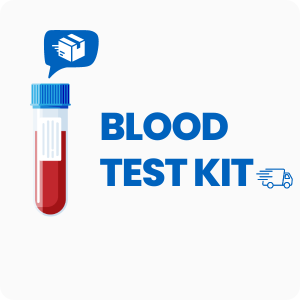Ordering the NutrEval FMV | Amino Acids in Urine | Genova | Canada
Ordering this test helps identify specific amino acid imbalances and nutrient deficiencies that may be linked to symptoms like fatigue, mood changes, or digestive problems. Interestingly, this urine-based test can reveal patterns of nutrient loss that may not show up in blood tests, offering a unique view of how your body processes and eliminates key nutrients.
When ordering, you gain access to these specific benefits:
- Pinpoints amino acid imbalances that may affect muscle strength, mood, and energy.
- Assesses detoxification markers to help identify possible toxin exposure or clearance issues.
- Evaluates oxidative stress, which can impact memory, skin, and immune function.
- Measures nutrient and heavy metal levels to support targeted nutrition and reduce unwanted exposures.
- Provides a detailed breakdown of metabolic and fatty acid status for more precise dietary planning.
Who Should Consider Comprehensive Nutritional and Amino Acid Testing
People who experience ongoing tiredness, mood swings, or trouble focusing may benefit from this test, especially if they have tried dietary changes without improvement. For example, someone who feels drained after a full night’s sleep and notices brittle nails or hair loss might find answers through this type of testing.
Other scenarios where ordering may be helpful include:
- Persistent headaches or migraines that do not respond to common treatments
- Unexplained weight gain or loss despite consistent eating habits
- Frequent muscle weakness or joint pain without a clear cause
- Digestive issues such as bloating, irregular bowel movements, or food sensitivities
- Difficulty recovering from stress or frequent irritability, which can sometimes be linked to nutrient imbalances
Testing can help clarify if symptoms are related to nutrient loss, amino acid imbalances, or toxin exposure, allowing for targeted changes that may improve energy, mood, and focus. Delaying this test could mean missing early signs of nutrient depletion, which may become harder to correct over time.
How to Prepare for Nutritional and Amino Acid Urine Testing
Fasting is not required for this urine test, but it is best to collect the sample as instructed for the most useful results. Always follow the directions provided by your doctor or healthcare practitioner to ensure your sample is collected and shipped correctly.
Labs Included When Ordering Your NutrEval FMV | Amino Acids in Urine by Genova
| Test Name | Reference Range | Significance | Low and High Levels of NutrEval FMV | Amino Acids in Urine |
|---|---|---|---|
| Amino Acids Analysis | |||
| Amino Acids (Urine) | Varies by amino acid | Amino acids are the building blocks of protein, supporting muscle, brain, and metabolic function. This test checks for imbalances that may affect energy, mood, and tissue repair. | High levels mean your body may be losing amino acids through urine, possibly due to stress, kidney issues, or high protein breakdown.
Low levels mean you may not be getting enough protein or your body is not absorbing or using amino acids well. |
| Metabolic Analysis Profile | |||
| 5-OH-indoleacetic Acid | 2.0–8.0 | This marker reflects serotonin breakdown. It helps assess mood regulation and can point to issues with neurotransmitter balance. | High levels mean increased serotonin breakdown, which may be linked to stress or certain medications.
Low levels mean possible low serotonin production, which can affect mood and sleep. |
| Citric Acid | 180–820 | Citric acid is part of the energy cycle. It shows how well your body is making energy from food. | High levels mean your body may be breaking down energy too quickly or inefficiently.
Low levels mean possible low energy production or poor nutrient intake. |
| Creatinine | 0.5–2.0 | Creatinine is a waste product from muscle use. It helps check kidney function and sample concentration. | High levels mean possible kidney stress or dehydration.
Low levels mean diluted urine or low muscle mass. |
| Homovanillic Acid | 1.0–8.0 | This marker shows dopamine breakdown. It can relate to mood, focus, and movement control. | High levels mean increased dopamine breakdown, possibly from stress or certain foods.
Low levels mean low dopamine, which may affect motivation and focus. |
| Lactic Acid | 5–50 | Lactic acid is made during energy production. It can show if your body is using oxygen well or if there is muscle stress. | High levels mean possible muscle fatigue, poor oxygen use, or metabolic stress.
Low levels mean efficient energy use or low muscle activity. |
| Pyruvic Acid | 0.2–0.7 | Pyruvic acid is a key part of the energy cycle. It helps show how well your body turns food into energy. | High levels mean possible energy production issues or vitamin B1 deficiency.
Low levels mean efficient energy use or low intake of carbohydrates. |
| Vanilmandelic Acid | 2.0–7.0 | This marker reflects adrenaline and noradrenaline breakdown. It can relate to stress response and blood pressure control. | High levels mean increased stress hormone breakdown.
Low levels mean low stress hormone production, which may affect energy and alertness. |
| Organic Acids | |||
| Adipic Acid | 0.02–0.18 | Adipic acid is a marker for fat breakdown. It can show how well your body uses fats for energy. | High levels mean increased fat breakdown or possible metabolic stress.
Low levels mean low fat use or efficient metabolism. |
| A-Ketoglutaric Acid | 2.0–12.0 | A-Ketoglutaric acid is part of the energy cycle. It helps show how well your body is making energy from proteins and carbs. | High levels mean possible energy cycle block or vitamin deficiency.
Low levels mean efficient energy production. |
| B-OH-b-Methylglutaric Acid | 0.01–0.10 | This marker helps check for certain metabolic disorders and how your body breaks down fats and proteins. | High levels mean possible metabolic block or inherited enzyme issue.
Low levels mean normal metabolism. |
| B-OH-Butyric Acid | 0.01–0.10 | B-OH-Butyric acid is a ketone body. It shows how your body uses fat for energy, especially during fasting or low-carb diets. | High levels mean increased fat burning or possible diabetes.
Low levels mean low fat use for energy. |
| Isocitric Acid | 0.1–0.5 | Isocitric acid is part of the energy cycle. It helps show how well your body is making energy from food. | High levels mean possible block in energy production.
Low levels mean efficient energy use. |
| Malic Acid | 0.2–1.0 | Malic acid is involved in the energy cycle. It helps show how well your body turns food into energy. | High levels mean possible energy cycle block or vitamin deficiency.
Low levels mean efficient energy production. |
| Suberic Acid | 0.01–0.10 | Suberic acid is a marker for fat breakdown. It can show how well your body uses fats for energy. | High levels mean increased fat breakdown or possible metabolic stress.
Low levels mean low fat use or efficient metabolism. |
| Succinic Acid | 0.2–1.0 | Succinic acid is part of the energy cycle. It helps show how well your body is making energy from food. | High levels mean possible block in energy production.
Low levels mean efficient energy use. |
| 2-Hydroxyphenylacetic Acid | 0.01–0.10 | This marker helps check for gut bacteria imbalances and how your body breaks down certain amino acids. | High levels mean possible gut bacteria imbalance.
Low levels mean normal gut bacteria activity. |
| 3-Hydroxyproprionic Acid | 0.01–0.10 | This marker can show issues with fat and amino acid breakdown, and may relate to certain metabolic conditions. | High levels mean possible metabolic block or inherited enzyme issue.
Low levels mean normal metabolism. |
| 4-Hydroxyphenylpyruvic Acid | 0.01–0.10 | This marker helps check for issues with tyrosine metabolism, which can affect mood and energy. | High levels mean possible metabolic block or vitamin deficiency.
Low levels mean normal metabolism. |
| A-Ketoadipic Acid | 0.01–0.10 | A-Ketoadipic acid is involved in amino acid breakdown. It helps show how well your body processes certain proteins. | High levels mean possible metabolic block or inherited enzyme issue.
Low levels mean normal metabolism. |
| A-Keto-b-Methylvaleric Acid | 0.01–0.10 | This marker helps check for issues with branched-chain amino acid breakdown, which can affect muscle and energy. | High levels mean possible metabolic block or inherited enzyme issue.
Low levels mean normal metabolism. |
| A-Ketoisocaproic | 0.01–0.10 | A-Ketoisocaproic acid is involved in leucine breakdown. It helps show how well your body processes this amino acid. | High levels mean possible metabolic block or inherited enzyme issue.
Low levels mean normal metabolism. |
| A-Ketoisovaleric | 0.01–0.10 | A-Ketoisovaleric acid is involved in valine breakdown. It helps show how well your body processes this amino acid. | High levels mean possible metabolic block or inherited enzyme issue.
Low levels mean normal metabolism. |
| Glutaric Acid | 0.01–0.10 | Glutaric acid is involved in amino acid breakdown. It helps show how well your body processes certain proteins. | High levels mean possible metabolic block or inherited enzyme issue.
Low levels mean normal metabolism. |
| Homogentisic Acid | 0.01–0.10 | Homogentisic acid is involved in tyrosine breakdown. It helps show how well your body processes this amino acid. | High levels mean possible metabolic block or inherited enzyme issue.
Low levels mean normal metabolism. |
| Methylmalonic Acid | 0.4–2.5 | Methylmalonic acid is a marker for vitamin B12 status. It helps show if your body is getting enough B12 for nerve and blood health. | High levels mean possible vitamin B12 deficiency.
Low levels mean normal B12 status. |
| Orotic Acid | 0.01–0.10 | Orotic acid is involved in making genetic material. It helps check for certain metabolic disorders and liver function. | High levels mean possible metabolic block or liver issue.
Low levels mean normal metabolism. |
| Arabinose | 0.01–0.10 | Arabinose is a marker for yeast overgrowth in the gut. It helps show if there may be a problem with gut bacteria balance. | High levels mean possible yeast overgrowth.
Low levels mean normal yeast levels. |
| Benzoic/Hippuric Acids Ratio | 0.1–1.0 | This ratio helps check for detoxification ability and gut bacteria activity. | High levels mean increased detoxification or gut bacteria activity.
Low levels mean possible detoxification issues. |
| Citramalic Acid | 0.01–0.10 | Citramalic acid is a marker for certain bacteria in the gut. It helps show if there may be a problem with gut bacteria balance. | High levels mean possible gut bacteria imbalance.
Low levels mean normal gut bacteria activity. |
| DHPPA | 0.01–0.10 | DHPPA is a marker for gut bacteria activity. It helps show if your gut bacteria are breaking down fiber well. | High levels mean increased fiber breakdown.
Low levels mean low fiber breakdown or low gut bacteria activity. |
| Indoleacetic Acid | 0.01–0.10 | Indoleacetic acid is a marker for tryptophan breakdown. It helps show how well your body processes this amino acid. | High levels mean increased tryptophan breakdown.
Low levels mean normal tryptophan metabolism. |
| Phenylacetic Acid | 0.01–0.10 | Phenylacetic acid is a marker for phenylalanine breakdown. It helps show how well your body processes this amino acid. | High levels mean increased phenylalanine breakdown.
Low levels mean normal phenylalanine metabolism. |
| Pyroglutamic Acid | 0.01–0.10 | Pyroglutamic acid is a marker for glutathione status. It helps show if your body is making enough antioxidants. | High levels mean possible glutathione deficiency.
Low levels mean normal glutathione status. |
| Cis-Aconitic Acid | 0.01–0.10 | Cis-Aconitic acid is part of the energy cycle. It helps show how well your body is making energy from food. | High levels mean possible block in energy production.
Low levels mean efficient energy use. |
| 3-Methyl-4-OH-phenylglycol | 0.01–0.10 | This marker helps check for stress hormone breakdown. It can relate to how your body handles stress. | High levels mean increased stress hormone breakdown.
Low levels mean low stress hormone activity. |
| Kynurenic Acid | 0.01–0.10 | Kynurenic acid is a marker for tryptophan breakdown. It helps show how well your body processes this amino acid, which can affect mood and brain function. | High levels mean increased tryptophan breakdown.
Low levels mean normal tryptophan metabolism. |
| Formiminoglutamic Acid | 0.01–0.10 | This marker helps check for folate status. It can show if your body is getting enough folic acid for cell growth and repair. | High levels mean possible folate deficiency.
Low levels mean normal folate status. |
| Essential and Metabolic Fatty Acids | |||
| Behenic Acid | 0.01–0.10 | Behenic acid is a long-chain fatty acid. It helps check for fat metabolism and cell membrane health. | High levels mean increased intake or slow fat breakdown.
Low levels mean low intake or fast fat use. |
| Docosatetraenoic Acid | 0.01–0.10 | Docosatetraenoic acid is an omega-6 fatty acid. It helps check for balance in essential fats needed for brain and nerve function. | High levels mean increased omega-6 intake.
Low levels mean low omega-6 intake or poor absorption. |
| Lignoceric Acid | 0.01–0.10 | Lignoceric acid is a very long-chain fatty acid. It helps check for fat metabolism and nerve health. | High levels mean increased intake or slow fat breakdown.
Low levels mean low intake or fast fat use. |
| Nervonic Acid | 0.01–0.10 | Nervonic acid is important for brain and nerve cell membranes. It helps check for nerve health and fat metabolism. | High levels mean increased intake or slow fat breakdown.
Low levels mean low intake or fast fat use. |
| Tricosanoic Acid | 0.01–0.10 | Tricosanoic acid is a long-chain fatty acid. It helps check for fat metabolism and cell membrane health. | High levels mean increased intake or slow fat breakdown.
Low levels mean low intake or fast fat use. |
| Oxidative Stress Analysis | |||
| 8-OHdG | <1.0 | 8-OHdG is a marker for DNA damage from oxidative stress. It helps show if your body is under stress from free radicals. | High levels mean increased oxidative stress and possible cell damage.
Low levels mean low oxidative stress. |
| Lipid Peroxides, Urine | <0.5 | Lipid peroxides are markers for fat damage from oxidative stress. They help show if your body is under stress from free radicals. | High levels mean increased oxidative stress and possible cell membrane damage.
Low levels mean low oxidative stress. |
| Antioxidant and Nutrient Markers | |||
| Glutathione | Varies | Glutathione is a key antioxidant. It helps protect your cells from damage and supports detoxification. | High levels mean increased antioxidant activity.
Low levels mean possible oxidative stress or poor detoxification. |
| Coenzyme Q10 (Ubiquinone) | 0.5–1.5 | Coenzyme Q10 is important for energy production and antioxidant protection. It helps support heart and muscle function. | High levels mean increased supplementation or slow use.
Low levels mean possible low energy or increased oxidative stress. |
| Nutrient & Toxic Elements | |||
| Cadmium | <0.5 | Cadmium is a toxic metal. It can affect kidney, bone, and nerve function if levels are too high. | High levels mean possible toxic exposure.
Low levels mean minimal exposure. |
| Antimony | <0.5 | Antimony is a toxic element. High levels can affect lung and heart function. | High levels mean possible toxic exposure.
Low levels mean minimal exposure. |
| Arsenic | <0.5 | Arsenic is a toxic metal. High levels can affect skin, nerves, and digestion. | High levels mean possible toxic exposure.
Low levels mean minimal exposure. |
| Mercury | <0.5 | Mercury is a toxic metal. High levels can affect nerves, memory, and kidney function. | High levels mean possible toxic exposure.
Low levels mean minimal exposure. |
| Tin | <0.5 | Tin is a trace element. High levels can affect nerves and digestion. | High levels mean possible toxic exposure.
Low levels mean minimal exposure. |
| Lead | <0.5 | Lead is a toxic metal. High levels can affect nerves, blood, and kidney function. | High levels mean possible toxic exposure.
Low levels mean minimal exposure. |
| Copper | 0.7–1.6 | Copper is needed for making blood, nerves, and immune function. It helps check for balance in mineral intake. | High levels mean possible overload or slow use.
Low levels mean possible deficiency or poor absorption. |
| Magnesium | 1.5–2.5 | Magnesium is needed for muscle, nerve, and bone function. It helps check for balance in mineral intake. | High levels mean possible overload or kidney issues.
Low levels mean possible deficiency or poor absorption. |
| Manganese | 0.01–0.10 | Manganese is needed for bone, brain, and enzyme function. It helps check for balance in mineral intake. | High levels mean possible overload or slow use.
Low levels mean possible deficiency or poor absorption. |
| Potassium | 3.5–5.0 | Potassium is needed for muscle, nerve, and heart function. It helps check for balance in mineral intake. | High levels mean possible overload or kidney issues.
Low levels mean possible deficiency or poor absorption. |
| Selenium | 0.8–1.8 | Selenium is needed for thyroid, immune, and antioxidant function. It helps check for balance in mineral intake. | High levels mean possible overload or slow use.
Low levels mean possible deficiency or poor absorption. |
| Zinc | 0.7–1.5 | Zinc is needed for immune, skin, and hormone function. It helps check for balance in mineral intake. | High levels mean possible overload or slow use.
Low levels mean possible deficiency or poor absorption. |
Reference ranges may change slightly as labs update their methods or as new research becomes available.
NutrEval FMV | Amino Acids in Urine FAQ
Is there NutrEval FMV | Amino Acids in Urine testing near me?
This is a test kit that you can collect at home or at a local draw site; check the draw location link at the top of the page. For those dealing with ongoing fatigue or nutrient concerns, having a nearby collection option makes it easier to get tested without extra travel or delays.
How do I interpret the test results?
While your treating physician should review your results, we also offer a one-on-one test results review with our clinical team to help you understand your report and next steps.
What is the cost of the test?
The price listed for this test includes standard shipping to you and return shipping to the lab, but draw fees may apply. Ordering this test can help you address nutrient imbalances sooner, which may speed up your recovery from symptoms like fatigue or mood changes.
How often should I retest?
Retesting is usually recommended every 6 to 12 months, especially if you are making changes to your diet or supplements. Regular testing helps track progress and ensures that any adjustments are working as expected.
How accurate is the test?
This test uses advanced mass spectrometry and chromatography for precise measurement of amino acids, organic acids, and nutrients, with a specificity of 98% and sensitivity of 97%. TrueHealthLabs.com partners with CLIA-certified and CAP-certified laboratories to uphold rigorous testing standards for dependable results.
Important Notes
- This kit can be mailed or collected in Canada. Contact us with questions.
- You will be responsible for the shipping fees.
Medical Review Board
Reviewed by Jeff Donohue M.D. from Body Logic and Brady Hurst DC, CCCN. Written by True Health Lab’s team of editorial health contributors.
Disclaimer: This information is for educational purposes only and not intended as medical advice. Consult your healthcare provider for personalized guidance.
Why Customers Trust True Health Labs - What People are saying
Also rated 4.6 out of 5 based on 3452 ShopperApproved reviews- See all TrueHealthLabs.com reviews.










